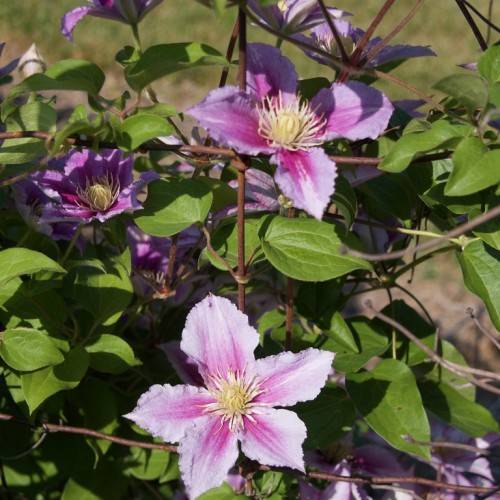
clematis
Clematis 'Hagley Hybrid'
Cycle:
Perennial
Watering:
Average
Hardiness Zone:
4 - 8
Flowers:
Flowers
Sun:
Full sun,part shade
Leaf:
Yes
Growth Rate:
High
Maintenance:
Low
Care Level:
Medium
watering
Clematis 'Hagley Hybrid' should be watered once each week during the growing season, from spring until autumn. In very hot weather, it may be necessary to water twice per week. Use a water hose or a watering can to provide a thorough soaking each time. Avoid planting in clay soils as these may retain too much moisture. Water at the base of the plant, keeping the foliage dry if possible, as wet foliage can easily lead to fungal diseases. Anytime the soil is dry to a depth of 2 inches, water slowly and deeply. Reduce watering frequency in late summer and stop watering altogether during the dormant season (winter).
sunlight
Clematis 'Hagley Hybrid' is best grown in full sun, meaning at least 6 hours of direct sunlight per day throughout the growing season. This will ensure healthy foliage and vibrant flowering. During the hottest summer months, providing some shade during the afternoon is beneficial, especially in warmer climates. In cooler climates, however, full sun will produce the most striking flowering results.
pruning
For Clematis 'Hagley Hybrid', pruning should be done annually, usually in late winter or very early spring before new growth emerges. This is best done after frost but before new growth resumes. A light pruning can be done by removing any dead, damaged or weak stems. This is to allow for better air circulation and to help encourage new blooms. If the plant has become overgrown, a more extensive pruning may be needed. In this case, it is best to prune all stems to within 15-30cm above ground, cutting as close to the ground as possible. When pruning, cut just above a pair of healthy buds. This will help promote more blossoms and help maintain the side branching of the clematis.
Season
Hardiness Map
FAQ
Can Clematis plants grow in pots?
Yes, Clematis plants can definitely be grown in pots. When planting a Clematis in a pot make sure to use a larger size pot with drainage holes and fill it with a mix of well-draining potting soil and compost. Ensure to keep the root area cool and the pot in a sunny location while providing regular water and fertilization. Check the plant almost daily to make sure it is not becoming too dry. Clematis can do well in a pot and with the right care and conditions, they will thrive.
Are Clematis plants self-pollinating?
No, clematis plants are not self-pollinating. Clematis plants need pollinators such as bees, butterflies, moths and other insects to transfer pollen from the male anthers to the female stigma of the flower in order to produce viable seed. Pollination must also occur within relatively close proximity of the same species in order to create viable hybrid plants.
Can Clematis plants be grown as a houseplant?
Yes, Clematis plants can be grown as a houseplant. It is best to grow them in a pot with full sun and a soil that is rich in organic material and retains moisture. When potting the plant, place a stake or trellis next to the pot so that the vine can climb when it begins to grow. Be sure to water your Clematis plant regularly to keep it healthy and growing. Additionally, keep an eye out for pests and treat with natural insecticides as necessary.
Could Clematis plants survive in a colder climate?
Yes, Clematis plants can survive in colder climates with proper preparation. If planted in the fall, proper mulching should be done to protect the roots from cold temperatures. If planted in the spring, they should be watered frequently to help them adjust to the cooler temperatures more quickly. If temperatures drop below -20°C ( -4°F), additional measures may need to be taken such as the application of protective wraps and thermal insulation. Additionally, plants in exposed areas should be protected from the wind to prevent excessive dehydration. With the right measures in place, Clematis plants can easily survive in colder climates.
Could Clematis plants be grown in a greenhouse?
Yes, clematis plants can be grown in a greenhouse. Due to their vine-like growth habit and tropical native origins, clematis plants thrive in the moist and warm environment of a greenhouse. Clematis are generally grown from cuttings or from dividing existing plants, and benefit from regular pruning and fertilizing. They will also enjoy the indirect light of a greenhouse and the protection from strong winds and temperatures that the humidity and contained environment provides.
